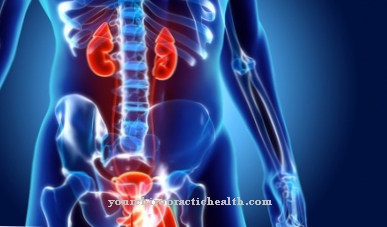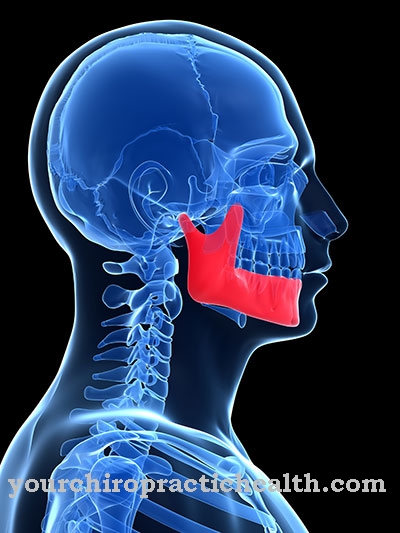Lower spine pain characterizes the Coccygodynia or the Tailbone pain. The disease often heals after a few weeks. Symptoms are usually treated medically.
What is coccygodynia?

The Coccygodynia is sometimes also called Coccyx neuralgia designated. This makes coccygodynia a disease that manifests itself in the lower spine at the level of the coccyx (some vertebrae that are atrophied and connected), primarily through characteristic pain.
The pain that occurs when coccygodynia is present is often burning, drawing, or stabbing. As a rule, the pain of coccygodynia occurs primarily in a sitting position.
From a developmental point of view, the coccygodynia affected coccyx is a regressed part of the caudal skeleton. The name of coccygodynia goes back to the bone group (Os coccygis) that is affected by pain in the disease.
Coccygodynia is a disease that occurs relatively rarely. If coccygodynia occurs, women are predominantly affected.
causes
Possible causes of a Coccygodynia are diverse. Coccygodynia cannot always be traced back to a specific cause. Coccygodynia is often the result of injuries that occur when falling on the buttock region.
But coccygodynia can also be caused by other stresses; for example by sitting on hard surfaces for a long time. Coccygodynia can also be caused by other underlying diseases: for example, so-called lumbar pain (popularly known as lumbago), herniated discs or tumors in the region of the coccyx can lead to coccygodynia.
Coccygodynia can also be caused by gynecological diseases or by malformations of the tailbone. In addition, childbirth or surgery can promote coccygodynia. In many cases, coccygodynia is also based on psychological stress.
Symptoms, ailments & signs
Coccygodynia has clear symptoms. The disease is characterized by burning or throbbing pain in the area of the coccyx. Those affected often feel a strong pulling or stinging, combined with overheating of the affected body area. The symptoms are not necessarily limited to the coccyx region, but can also radiate to the upper spine and the lumbar region.
The pain occurs particularly when standing up and when sitting. Often times, the pain is so severe that activities such as sexual intercourse and bowel movements are no longer possible. This can lead to further symptoms of a psychological nature. This can be accompanied by general symptoms such as malaise and fever.
In addition, the constant relieving posture can lead to misalignments, joint and bone pain, tension and cramps. The signs of the disease usually subside after a while. In individual cases, chronic complaints can arise. Possible secondary symptoms are coordination disorders, restricted mobility, circulatory disorders and nerve pain.
The respective underlying disease can possibly cause further unspecific symptoms. Typical psyche complications include depressive moods, panic attacks and irritability. Provided that the individual symptoms and complaints of coccygodynia are treated early, the health problems can be relieved reliably and quickly.
Diagnosis & course
To a Coccygodynia To diagnose, a comprehensive consultation with a doctor usually takes place first. This conversation is then followed by a physical exam.
If coccygodynia is suspected in this context, this suspicion can be confirmed by various methods. Which diagnostic method makes sense depends, among other things, on the suspected cause of coccygodynia. For example, performing an MRI (magnetic resonance tomography) or CT (computed tomography) scan of the pelvic region can be helpful. The ultrasound method is also used to diagnose organically caused coccygodynia.
Depending on the cause of coccygodynia, this can develop very differently from person to person. In many cases coccygodynia lasts for a few days to weeks and then subsides again. Occasionally, coccygodynia can last for several years and eventually develop into a chronic form.
Complications
In most cases, coccygodynia will cure the disease without medical treatment. In most cases, the pain in the spine disappears on its own and there are no particular complications. It is not uncommon for those affected to suffer from burning or stabbing pain.
This pain can spread from the tailbone to other regions of the body and lead to considerable discomfort in these regions as well. The quality of life of the person affected is significantly restricted and reduced by coccygodynia. Likewise, it is not uncommon for restrictions in movement and coordination disorders to occur. Certain activities or sports are usually no longer possible for the person concerned.
These restrictions often lead to psychological complaints or other upsets and depression. In most cases, the treatment itself only takes place symptomatically, so that the painkillers in particular are treated with the help of medication or various therapies. There are no particular complications. In most cases, coccygodynia does not reduce life expectancy.
When should you go to the doctor?
If pulling, stabbing or burning pain is noticed in the area of the coccyx, it should be taken to the family doctor or a sports doctor as soon as possible. If the symptoms arise after an accident or a fall, it is advisable to see a doctor immediately. Other warning signs that should be clarified are pain when defecating or having sexual intercourse as well as difficulty getting up or sitting down. If these symptoms are noticed, there may be an underlying health problem that needs treatment.
Anyone who has recently suffered a contusion of the tailbone, a herniated disc or a gynecological disease is particularly prone to developing coccygodynia. Tumors in the coccyx area as well as lumbago and the root irritation syndrome are among the risk factors that must be clarified quickly. Affected people should visit their family doctor or an orthopedic surgeon within a few days and have the symptoms clarified. Other contact persons are the chiropractor and specialists for the respective complaints. Children who complain of tailbone pain should be presented to a pediatrician.
Treatment & Therapy
The therapy one Coccygodynia is initially based on the causes underlying the disease in the individual. In cases in which no organic causes for coccygodynia can be found, medical treatment for coccygodynia usually centers primarily on combating symptoms; fighting the pain.
The pain that occurs with coccygodynia can be countered with the help of a local anesthetic (a means of local anesthesia), for example. The anesthetic is injected into the painful part of the body and relieves the pain within the scope of its duration.
Measures that can relieve pain include, for example, targeted physiotherapy, acupuncture or various relaxation methods. Aids that can help provide short-term pain relief in coccygodynia are seat wedges or rings.
If coccygodynia is based, among other things, on psychological factors, individual psychotherapies can help combat the pain. If coccygodynia is associated with very pronounced and continuous pain in a person affected, there are ways to ensure a long-term supply of anesthetic or pain-relieving agents via catheters.
You can find your medication here
➔ Medicines for back painOutlook & forecast
Coccygodynia can basically be cured. The treatment plan is based on the cause of the symptoms. In many patients, spontaneous healing can be documented. This is especially possible if there was a short-term overexertion and the body can regenerate through its ability to heal itself. If there is permanent stress on the lower spine, the prognosis worsens. In these cases, sudden sustained regression is unlikely. The person concerned is subjected to physiotherapy training and has to change his everyday life.
Relief of the affected region is necessary to improve his health. The movement sequences must be changed over the long term and aligned with the needs of the organism. By optimizing the stress and redesigning everyday life, long-term alleviations of the symptoms can be achieved. Otherwise there is a threat of an increase in pain. In addition, secondary diseases can break out due to the persistent symptoms, which cause a further deterioration in the overall condition.
The prognosis is particularly unfavorable if there is a tumor disease. Cancer therapy is needed and removal of the tumor is indicated. Treatment and surgery are associated with numerous risks and side effects. There is a deterioration in the quality of life and severe psychological stress. At an advanced stage of the disease, the patient is threatened with premature death.
prevention
To a Coccygodynia To prevent injuries, for example, it can be helpful to treat tailbone injuries promptly. This is possible with the help of pain relieving ointments. Getting early examinations for pelvic diseases that may contribute to coccygodynia can also help prevent coccygodynia. To prevent psychological conflicts from leading to coccygodynia, these can be dealt with psychotherapeutically, for example.
Aftercare
The follow-up measures prove to be relatively difficult in most cases of coccygodynia. In the case of this disease, the reason for the disease must usually first be identified so that no further compilations can occur. In many cases, coccygodynia can go away on its own, so that aftercare is no longer necessary.
As a rule, those affected should take it easy with this disease and not engage in stressful, physical or strenuous activities. Above all, the legs should be particularly spared, although bed rest or the use of various walking aids can have a positive effect on coccygodynia. Painkillers can also be taken in the event of pain, whereby it is important to ensure the correct dosage and regular intake.
A doctor should always be consulted if anything is unclear or if you have any questions. Furthermore, measures of physiotherapy or physiotherapy can have a positive effect on the course of the disease. Patients can repeat many of the exercises at home and thereby accelerate the healing of coccygodynia. The disease does not usually reduce the life expectancy of those affected.
You can do that yourself
With coccygodynia, the person affected has various options for self-help. The disease can usually be avoided simply by examining and treating injuries or discomfort to the tailbone very quickly. Pain-relieving ointments or creams can also have a positive effect on the course of the disease. Regular examinations in the pelvic area are also advisable, especially if there are complaints in this area.
The pain of coccygodynia can be relieved by various therapies. Acupuncture or various relaxation exercises, such as yoga, are suitable. Furthermore, various objects, such as seat wedges, can also promote pain relief for the patient. In the case of very severe pain or acute emergencies, however, these should be examined and anesthetized by a doctor.
If coccygodynia leads to psychological complaints, discussions with a psychologist or a therapist can help. Discussions and contacts with other affected persons or with close friends or family are also useful. Other people affected can contribute to an exchange of information and possibly offer advice on reducing the symptoms.





.jpg)



















.jpg)


